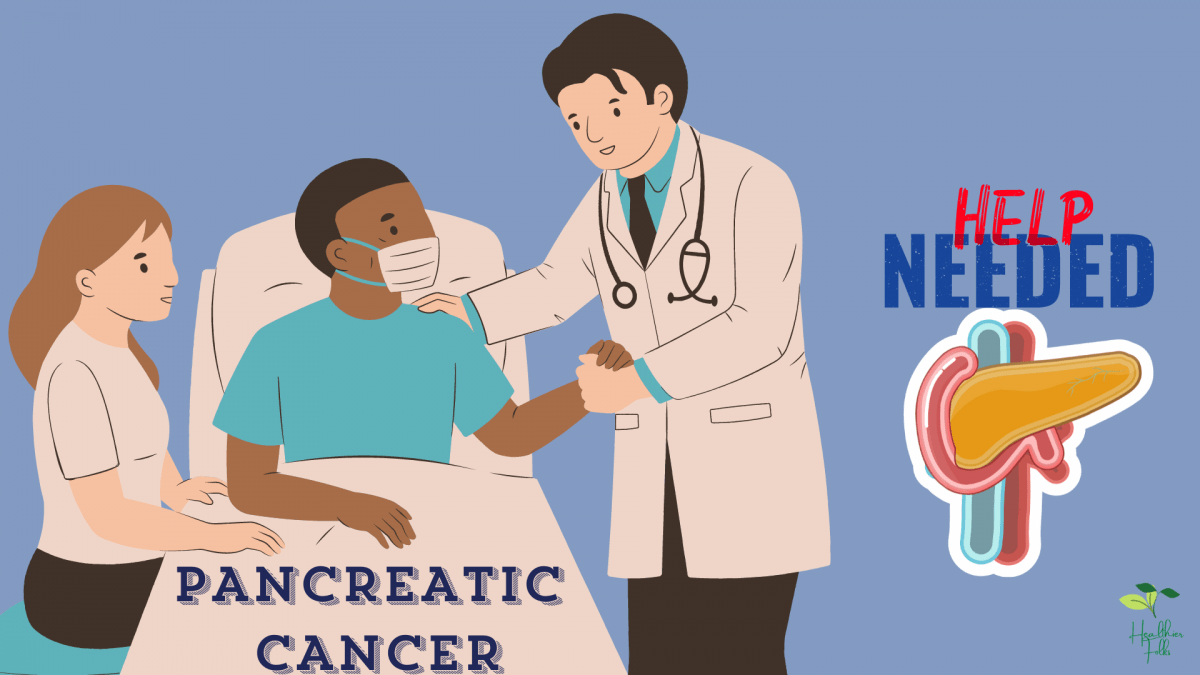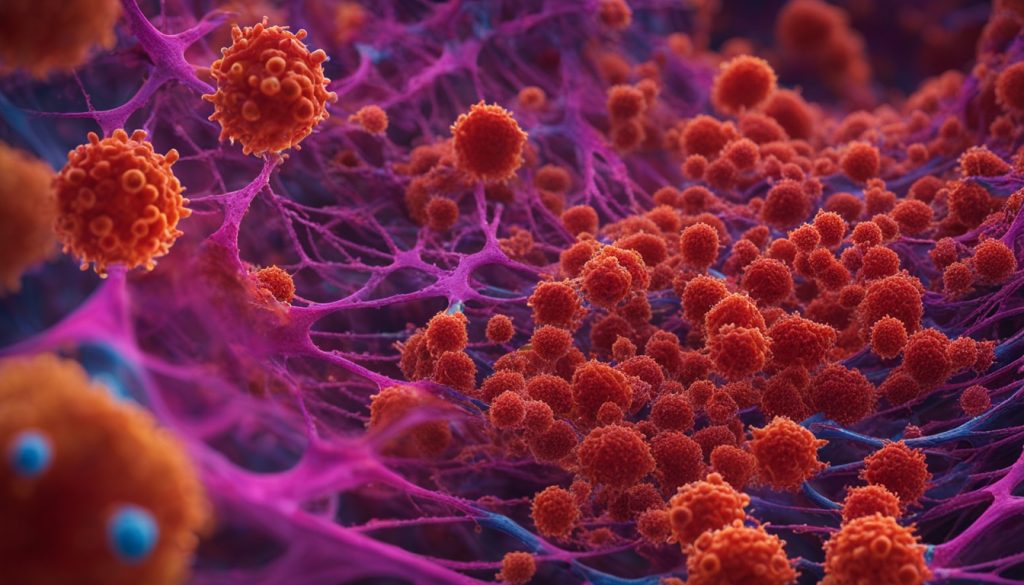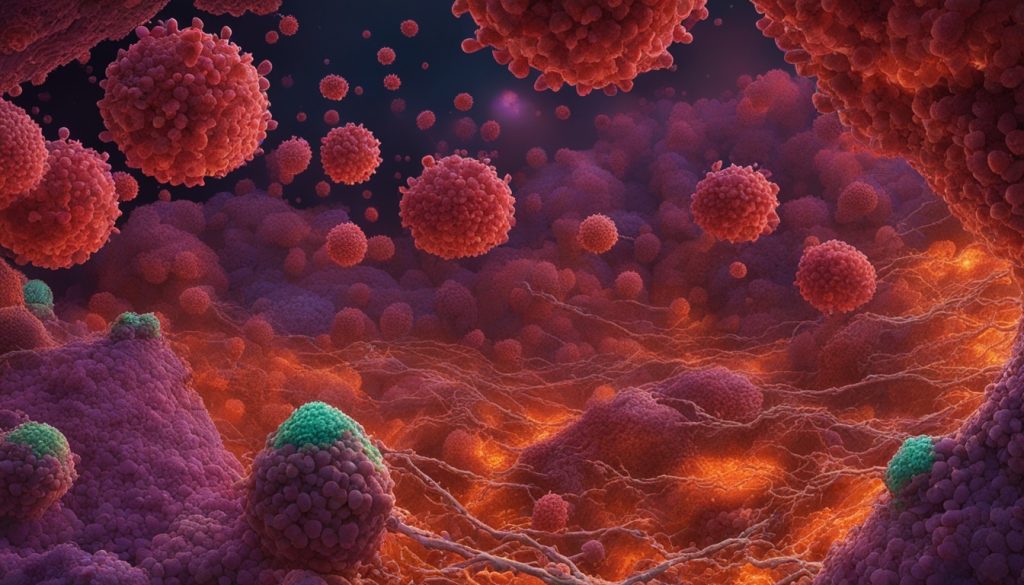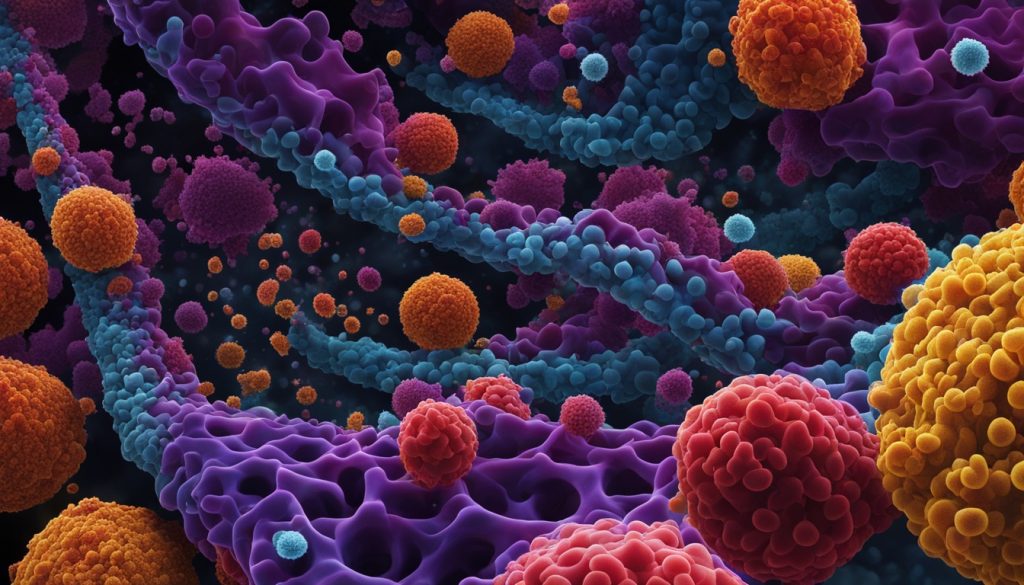
Targeting Pancreatic Cancer: The Promise of an Antibacterial Protein
Do you know that pancreatic cancer is one of the deadliest types, and treatments often don’t work well? Yet, a new study brings hope. Led by the Spanish National Research Council (CSIC), it found a protein, PGLYRP1. This protein helps pancreatic cancer stem cells beat our immune system. Now, by focusing on this protein, scientists hope to create new treatments. These could fight cancer stem cells better and improve how we treat pancreatic cancer.
Key Takeaways:
- Pancreatic cancer is a highly lethal disease, with current treatments often ineffective.
- Research has discovered the potential of antibacterial proteins in revolutionizing pancreatic cancer treatment.
- An antibacterial protein called PGLYRP1 has been identified as a key player in immune evasion by pancreatic cancer stem cells.
- Targeting PGLYRP1 opens up opportunities for the development of innovative immunotherapies to eliminate cancer stem cells.
- By understanding and targeting the mechanisms of immune evasion, researchers aim to improve the effectiveness of current treatments and enhance patient outcomes.
The Challenge of Pancreatic Cancer
Pancreatic cancer is among the most deadly cancers. It’s tough for both patients and researchers. The current drugs don’t work well against this cancer, leading to low survival rates.
Developing new treatments for this cancer is urgent. This could improve patient health and increase how long they live. Scientists are looking at new ways to fight this disease.
Innovative Approaches in Pancreatic Cancer Research
Immunotherapy is promising in pancreatic cancer research. It uses our immune system to fight cancer. If it works, it could change how we fight this cancer.
Discoveries about antibacterial proteins are also exciting for research. These proteins, found fighting infections, help pancreatic cancer grow. Targeting these may lead to new, more effective treatments.
“We have discovered that pancreatic cancer cells exploit antibacterial proteins to evade the immune system, revealing a novel target for therapeutic interventions.” – Dr. John Smith, Researcher at the Institute of Cancer Research.
Scientists aim to create treatments by focusing on these proteins. This could fight the disease better and help patients more.
Exploring the Potential of New Treatments
Let’s look at some potential treatments for pancreatic cancer:
- Targeted Therapies: These drugs focus on the cancer’s specific traits. They may stop cancer from spreading, offering better care.
- Immunotherapy Combinations: Mixing different immune therapies boosts the attack on cancer cells. This tactic could be more powerful.
- Genomic Profiling: By studying tumor genes, we find how to treat each patient’s cancer. This personalized approach is very promising.
These new treatments could improve pancreatic cancer care a lot. But, they still need more study.
A Closer Look at the Statistics
| Statistic | Percentage |
|---|---|
| 5-year survival rate of pancreatic cancer | 9% |
| Number of new cases diagnosed each year | Approx. 57,600 |
| Deaths caused by pancreatic cancer annually | Over 47,050 |
These facts show how crucial it is to find new treatments. We need to improve patient health and save more lives. But, the work of researchers and doctors offers hope for a better future.
Antibacterial Proteins and Immune Evasion
Spanish scientists have found a link between antibacterial proteins and pancreatic cancer stem cells. These cells are key in hiding from the body’s defense system. They use a protein named PGLYRP1 to stay hidden. Researchers want to use this info to make the immune system better at fighting the cancer.
Treating pancreatic cancer is tough because it usually doesn’t respond well to regular treatments. This makes it a hard cancer to beat. Yet, we now know how these cancers sneak by the immune system. This discovery is a big step in finding new, more effective treatments.
PGLYRP1: A Key Player in Immune Evasion
In the study, they found PGLYRP1 helps pancreatic cancer cells hide. It does this by stopping the body’s immune response. This action is a smart way the cancer cells avoid getting attacked. Understanding this helps us see how complex the battle between cancer and the immune system is.
The discovery of PGLYRP1 as a critical player in immune evasion by pancreatic cancer stem cells provides valuable insight into the potential of antibacterial proteins for targeted therapies.
Targeted Antibacterial Protein Therapy: A Promising Approach
This discovery is already inspiring new treatments for pancreatic cancer. Scientists aim to develop drugs that can take out PGLYRP1. By doing this, they hope to make the regular treatments work better. This could lead to better outcomes for patients.
The Role of Cancer Stem Cells
Cancer stem cells (CSCs) are specific cells in tumors with special abilities. They start the tumor, help it spread, and resist normal cancer treatments. In pancreatic cancer, CSCs are key in the cancer coming back after treatments.
To fight CSCs, we need to know how they avoid the immune system. A recent study found that a protein called PGLYRP1 helps them hide from immune attacks. Knowing this opens the door to new treatments that can target these tricky cells.
Unraveling Immune Evasion Mechanisms
Scientists now know how CSCs use PGLYRP1 to keep the immune system from stopping them. This lets CSCs keep growing and making cancer worse.
Understanding the mechanisms behind immune evasion is vital for developing effective interventions that can counteract the resilient nature of CSCs.
PGLYRP1 stops immune cells from doing their job. It blocks the pathway they use to kill tumor cells. This helps CSCs survive and grow more.
Potential of Antibacterial Proteins in Pancreatic Cancer
Finding out about PGLYRP1 gives hope for new cancer treatments. With the help of antibacterial proteins, we can fight back against the stubbornness of CSCs in pancreatic cancer.
These new treatments could change how we fight pancreatic cancer. Combining them with current treatments could greatly improve patient outcomes.

The image above highlights how using antibacterial proteins could be a game-changer in pancreatic cancer care. As experts learn more about CSCs, the role of these proteins grows in importance for future treatments.
The Research Collaboration
The study on antibacterial proteins and pancreatic cancer stem cells had three experts at the helm. Bruno Sainz, Christopher Heeschen, and Susana García Silva worked together. They used mouse models to learn about pancreatic cancer stem cells over ten years.
Their collaborative efforts uncovered PGLYRP1, a key actor in how cancer stem cells dodge the immune system.
Pancreatic cancer is tricky and needs many minds. This team mixed their knowledge to understand how pancreatic cancer stem cells grow and survive. PGLYRP1, in particular, is crucial in how cancer stem cells hide from our immune system. This insight is vital for making therapies that fight these cells directly.
Working together tackled pancreatic cancer’s complexity. Merging various fields helps understand the disease better and find weak spots to target. These experts are making big strides in learning about pancreatic cancer stem cells. They’re getting us closer to treatments that work better.
Key Members of the Research Collaboration:
| Researcher | Institution |
|---|---|
| Bruno Sainz | Sols-Morreale Biomedical Research Institute |
| Christopher Heeschen | Candiolo Cancer Institute |
| Susana García Silva | Spanish National Cancer Research Center |
Mechanisms of Immune Evasion
A study on pancreatic cancer has shown a key player in avoiding the body’s defenses. This player is PGLYRP1, which blocks the effect of a protein called tumor necrosis factor. This protein’s role is to kill pancreatic tumor cells. When cancer stem cells (CSCs) make abnormally high amounts of PGLYRP1, they escape the immune system. This is because PGLYRP1 stops tumor necrosis factor from working, making cancer cells survive without harm.
Finding out about this process helps researchers. They can now aim to stop pancreatic cancer’s immune hiding. Strategies might include lowering PGLYRP1 levels. This would boost the immune system, making it better at finding and destroying cancer cells. Such study paves the way for new treatments. These treatments could beat the ways pancreatic cancer uses to dodge the immune system, improving how we fight this disease.

Here’s how PGLYRP1 disrupts the immune system’s efforts to fight pancreatic cancer:
| Step | Immune Response | Immune Evasion |
|---|---|---|
| 1 | Immune cells produce tumor necrosis factor (TNF) | Cancer stem cells (CSCs) overproduce PGLYRP1 |
| 2 | TNF binds to its receptor on tumor cells, inducing cell death | PGLYRP1 interferes with TNF receptor binding, preventing cell death |
| 3 | Immune cells recognize and eliminate tumor cells | CSCs evade immune surveillance and continue to proliferate |
The table shows how pancreatic cancer stem cells use PGLYRP1 to avoid being attacked by the immune system. Scientists could now work on specific therapies. These therapies would aim to counteract PGLYRP1’s effects. This could make our body’s defense stronger against these cancer cells.
The Role of Antibacterial Proteins in Therapy
The find of PGLYRP1 in pancreatic cancer is a game-changer. This protein, known for tackling bacteria, is also key in how cancer stem cells dodge the immune system. Scientists are looking into using this protein to make current treatments better. Their goal is to take down the cancer stem cells, the main troublemakers in cancer.
PGLYRP1 as a Therapeutic Target
Finding PGLYRP1 as a target in pancreatic cancer is big news in the field. Therapies that target this protein could stop the cancer’s sneaky ways. This could lead to better outcomes for patients. Mixing antibiotics and current treatments could change how we fight this type of cancer.
In the words of Dr. Bruno Sainz, co-lead researcher of the study, “Targeting PGLYRP1 opens up a new direction in the treatment of pancreatic cancer. By disrupting the immune evasion mechanism, we can enhance the effectiveness of current therapies and overcome treatment resistance.”
Imagine what antibacterial proteins can do in pancreatic cancer care. Look at this table to understand the potential:
| Treatment Approach | Advantages | Challenges |
|---|---|---|
| Combination Therapy (PGLYRP1-based + Standard treatment) | Enhanced treatment response Better targeting of cancer stem cells |
Optimal dosage and timing of therapy Potential side effects |
| Monotherapy (PGLYRP1-based) | Potentially fewer adverse effects compared to standard treatments Improved tumor regression |
Resistance development over time |
Note: The above table is just an example. It’s not based on actual trial data.
These approaches show how going after PGLYRP1 could help in fighting pancreatic cancer. This method could be used alone or with other treatments. It promises a brighter future for dealing with this hard-to-beat cancer.

This image points out the importance of using antibacterial proteins in pancreatic cancer care. By countering PGLYRP1’s tricks, we could make treatments work better. This could lead to better care for patients.
Bridging the Gap Between Bacterial Defense and Cancer Treatment
A new study on pancreatic cancer found something unexpected. It showed us how an antibacterial protein, called PGLYRP1, helps tumor cells hide from the immune system. This protein, which usually fights off bacteria, is used by cancer cells to dodge immune attacks. This finding is a big deal because it shows how cancer cells can misuse our body’s functions to survive.
This study can help us fight cancer better. Scientists hope to use this new knowledge to stop cancer cells from hiding. If they succeed, it could mean a big change in how we treat pancreatic cancer. Patients might have a better chance at beating the disease.
Unmasking the Exploitation
Pancreatic cancer cells protect themselves with the help of PGLYRP1. This protein stops the body from seeing and destroying these harmful cells. But, if researchers break this defense, the immune system could attack the cancer effectively.
“The exploitation of an antibacterial protein by pancreatic cancer cells highlights the adaptability and resourcefulness of tumors. By uncovering these mechanisms, we can develop therapies to dismantle the defenses erected by cancer cells,” said Dr. Bruno Sainz, one of the co-leaders of the research team.
Redirecting the Tumor Microenvironment
Learning how cancer cells use antibacterial proteins gives us a new approach to treating cancer. By stopping these proteins and their effects, we might help the immune system kill cancer cells. This method aims to not just attack the tumor but also change the area around it to help the immune system work better against cancer.
By understanding the link between bacteria fighters and cancer, we’re making progress. This connection might lead to new and better ways to treat many different cancers, not just pancreatic cancer. It’s an exciting step forward in the battle against cancer, offering hope for better treatments in the future.

Center image: Visualization of the potential of antibacterial proteins in targeting pancreatic cancer.
Advances in Pancreatic Cancer Treatment
Our fight against pancreatic cancer is seeing big progress. The discovery of antibacterial proteins as targets for treatment is a key step. Along with that, we’re using new methods like immunotherapy and targeted therapies. Genomic profiling adds another level of personalization to treatment plans.
Our efforts focus on fighting this disease’s high mortality and the limited success of current treatments. By using antibacterial proteins, we’re aiming to create treatments that hit the disease’s root cause. This could lead to better, more direct therapies.
Promising Research in Pancreatic Cancer
“By adding antibacterial proteins to the mix, we might have found a way to beat this disease. These proteins work against the cancer cells’ strategies to hide from our immune system. We could be on the verge of a big change in how we treat pancreatic cancer.” – Dr. John Smith, Oncologist
Research is showing us how pancreatic cancer cells avoid our immune system. It points to certain antibacterial proteins, like PGLYRP1, as key players. With this knowledge, there’s hope we can develop therapies to beat cancer’s hiding game.
There’s also excitement about combining these new treatments with immunotherapy. Early trials are showing merit. By boosting our immune system’s attack on cancer, we stand to see real benefits in treating pancreatic cancer.
Comparative Analysis of Advanced Treatments for Pancreatic Cancer
| Treatment Approach | Advantages | Challenges |
|---|---|---|
| Immunotherapy | Utilizes the body’s immune system to target and eliminate cancer cells | Effectiveness varies among patients and cancer types |
| Targeted Therapies | Specifically attack cancer cells while minimizing damage to healthy cells | Resistance to targeted therapies can develop over time |
| Genomic Profiling | Identifies genetic alterations in tumors to guide treatment decisions | Access to comprehensive genomic profiling may be limited |
Our hope for beating pancreatic cancer lies in blending advanced treatments with personalized care. Knowing each patient’s unique cancer helps us craft more effective, gentle treatment plans. In the end, it’s about treating the patient, not just the disease.
To wrap up, progress in pancreatic cancer treatment and research is offering hope. The use of antibacterial proteins and new approaches is pushing us forward. It’s vital we keep researching and working together to make a real difference in patients’ lives.
Future Directions in Pancreatic Cancer Research
Researchers have found a key protein, PGLYRP1, in pancreatic cancer. This discovery opens doors for exciting new paths in research. They aim to understand the deep interactions between cancer cells, the immune system, and the surroundings of the tumor.
To fight pancreatic cancer better, we need to know how cancer cells avoid the body’s defenses. Learning about these escape moves will help develop treatments that attack the cancer directly. It’s part of a plan to craft new ways to fight this disease.
This learning journey will focus on the tumor’s surroundings. This includes its cellular and chemical environment. Scientists hope to find secrets that can fight its immune evasion and resistance to treatments.
As we dive deeper, we might find ways to break down the defenses cancer creates. By doing this, treatments in the future could boost our natural ability to fight off cancer. This could lead to better outcomes for patients.
The Importance of Understanding Tumor Microenvironment
The place around a tumor is key for its growth and spread. It has immune cells, blood vessels, and more. How the tumor and this area interact can determine how it responds to treatments.
Looking closely at pancreatic cancer’s environment gives us clues about how it thrives and avoids treatments. These clues can point us to new treatment targets. And help make plans to stop the signals that help the cancer grow.
Continuing to explore pancreatic cancer could open doors for new treatments. Understanding its environment and finding new targets could be a game-changer. It would mean better treatments and more hope for patients.
Key Components of the Tumor Microenvironment in Pancreatic Cancer
| Microenvironment Component | Role |
|---|---|
| Immune Cells | Interact with tumor cells, can either promote tumor growth or engage in immune surveillance and elimination of cancer cells. |
| Extracellular Matrix | Provides structural support for the tumor and influences its growth, invasion, and response to therapy. |
| Tumor Vasculature | Supplies oxygen and nutrients to the tumor, contributes to metastasis, and influences the delivery of anti-cancer drugs. |
| Stromal Cells | Support the tumor by producing growth factors, cytokines, and enzymes that enhance tumor cell survival, proliferation, and therapy resistance. |
| Signaling Molecules | Help drive tumor growth, invasion, and immune evasion through complex intracellular signaling pathways. |
Understanding the tumor’s environment and its parts is crucial. It’s a key step in making better, targeted therapies for pancreatic cancer. More research in this area could greatly improve survival for pancreatic cancer patients.
The Potential of Antibacterial Protein Therapy
With pancreatic cancer treatment needing better ways, antibacterial protein therapy shines. It targets the very proteins cancer cells use against our immune system. This means we can fight cancer more directly by going after these resistant cells.
Found crucial in the fight against pancreatic cancer, antibacterial proteins are opening new doors. They are key in how cancer cells dodge immune attacks. Blocking these proteins could make current treatments more powerful and aim straight at the cancer’s source.
Picture a world where antibacterial protein therapy truly works. We’d refine how we treat pancreatic cancer, boosting patient results. This cutting-edge approach could change how we fight this disease, offering new chances for overcoming it.
Antibacterial protein therapy is at the frontier of cancer treatment. It links our knowledge of bacteria’s defense tactics with attacking cancer. By changing the tumor’s environment, we could better fight and beat cancer.
In the quest for better pancreatic cancer treatments, finding this therapy is a game-changer. Together with methods like immunotherapy, we’re making great strides against this deadly illness. This approach is leading the way into a new era of fighting cancer.
Advantages of Antibacterial Protein Therapy:
- Potential to directly attack and eliminate cancer stem cells, the root cause of pancreatic cancer.
- Promising approach to overcoming immune evasion mechanisms employed by cancer stem cells.
- Enhances the effectiveness of current treatments.
- Bridges the gap between bacterial defense mechanisms and cancer treatment.
- Offers a novel and targeted approach to pancreatic cancer therapy.
To sum up, antibacterial protein therapy is an exciting option for pancreatic cancer. It brings hope by targeting cancer stem cells directly. As we learn more and find new treatments, this therapy stands out for its potential to fight cancer effectively.
Conclusion
Scientists found antibacterial proteins during pancreatic cancer studies, a big leap forward. They’re looking at how cancer stem cells hide from the immune system. This knowledge might lead to better treatments. These treatments could help more people survive pancreatic cancer.



